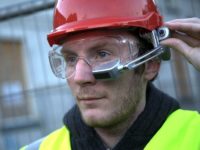Wearable technology could save lives and dollars in construction industry


At first glance, there’s nothing remarkable about SolePower’s latest work boot prototype. The Pittsburgh-based startup has gone through at least 20 other iterations of the boot, and this one took about six months to create.
The footwear looks normal—all black save for the company’s white and green logo. But after a few steps, rectangular sections in the heels illuminate a bright orange, reminiscent of the lights inside a traffic tunnel. That’s when you know they’re charging.
To tackle ongoing issues in the industrial work space, SolePower—which has won various awards, including a spot on Popular Science’s 2014 Invention Awards list for its proprietary self-charging shoe sole—has switched gears to create the first “self-charging, industrial wearable,” according to Cindy Kerr, commercial director.
This unplugged technology could play a role in efforts to improve safety and efficiency in the building, construction and oil and gas industries, according to Kerr. It could also become part of the ongoing debate over privacy issues, as employers and technology converge to more closely track what workers are doing and where they are going. Inside the SolePower boots are a variety of sensors, including those for temperature detection, GPS, Wi-Fi, electronics and inertial measurement units, which track location and motion. Each is powered by a kinetic charger that harnesses the untapped energy produced by walking.
“These are things we normally take for granted in a smartphone,” said Hahna Alexander, co-founder and CEO of SolePower, which was founded in 2012 and has five employees.
A growing number of industrial devices are equipped with safety indicators—such as equipment producer Cat’s Link technology, which allows a company to track its fleet of backhoes, excavators or compactors—but the SolePower gear is a wearable, joining the ranks of smart helmets, vests, glasses and even bionic suits. There’s a potentially sizable market to capture. Construction, for example, is one of the least digitized sectors in the world, according to research from The McKinsey Global Institute. In a report released earlier this year, the institute estimated the world will need to spend $57 trillion on infrastructure by 2030 to keep up with global GDP growth. In the construction sector, even a fraction of a percentage change in productivity could equate to substantial savings. It’s challenging to track workflow on job sites, so inefficiencies can go unnoticed, Kerr said.
“We need to know who is on the site and where they are at any given time … you can’t actually improve efficiency if you don’t measure.” Chad Hollingsworth, president and co-founder of Norwalk, Conn.-based safety and communications company Triax Technologies, agreed that manual tracking on a clipboard is ineffective. “Most of these job sites can’t tell you how many workers they have or where they are,” he said.
Fatal injuries in construction, which is among the most dangerous professions in the world, rose by 2 percent to 924 cases in 2015—the highest level since 2008, according to the 2015 National Census of Fatal Occupational Injuries report by the Bureau of Labor Statistics.
“They all have stories from the job sites, and some are horrific,” Hollingsworth said. “One fell down an elevator shaft and no one found him until they smelled him … they’re working in the most dangerous industry and they do want tools to keep safe.”
Currently, SolePower’s business model consists of an initial fee for the boots, which should compare to the price of a high quality work boot, Kerr said. While Kerr did not give an exact price for the SolePower boot, a pair of Timberland work boots cost anywhere from $145 to $200, on average. Wolverine’s line of Legend Durashocks soft toe work boots cost $160, comparatively. There’s also a monthly subscription charge for data services through an online dashboard. Triax uses a lease and service model wherein the cost of the system is absorbed into the cost of a job by listing spot-r as a safety fee. How successful the new technology is depends on convincing the employees that the new gear is worth it, Hollingsworth said. “You have to show workers that first and foremost this is a safety device.”
This article was originally written by and appeared here.


Comment (0)